Atkinson K. An Introduction to Numerical Analysis
Подождите немного. Документ загружается.

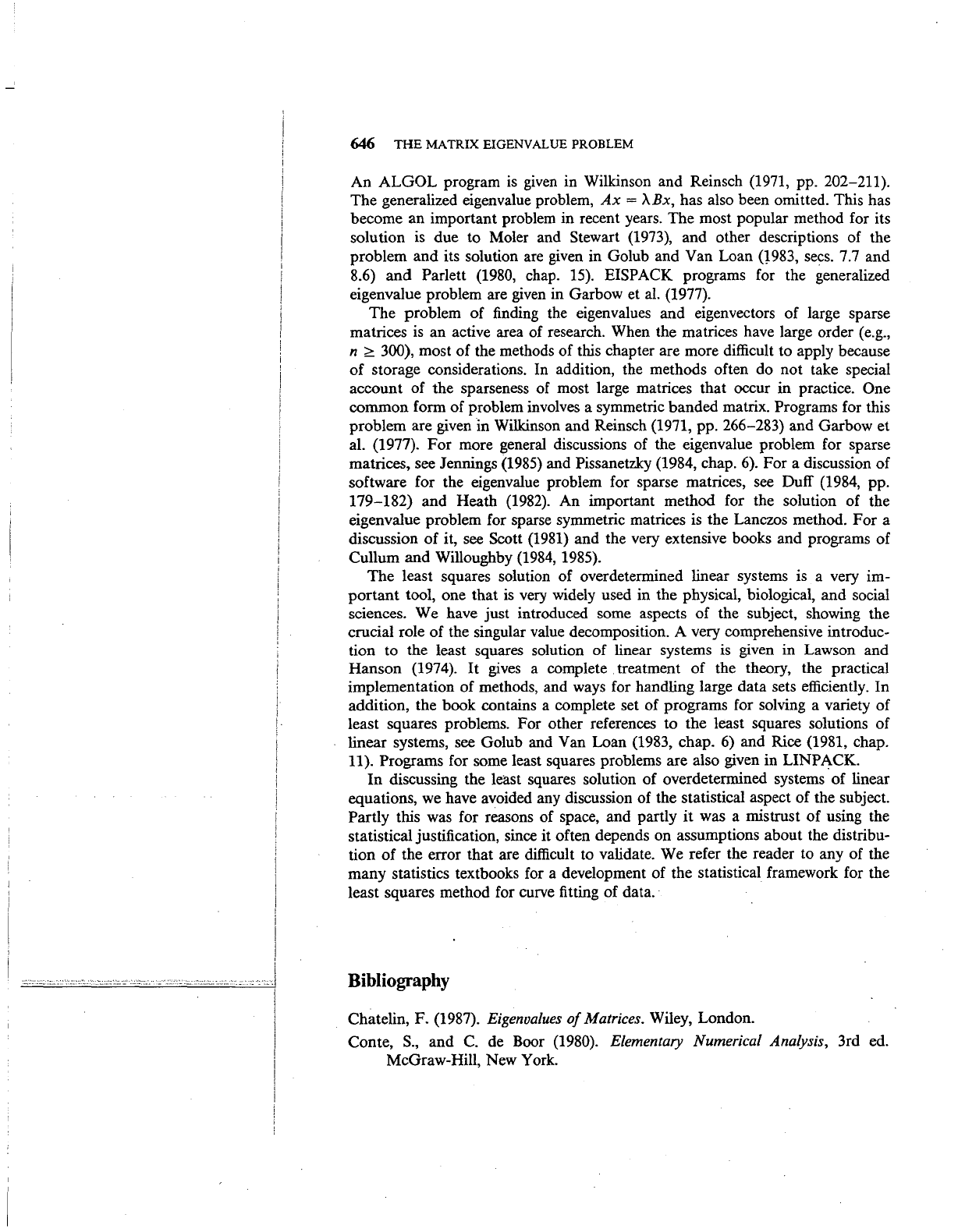
i
I
-·-·
·-·
......
-···-··
. _ ·····--
···-·-·
_
--··--
·:·.:.::
oc.:·:_::·.:·
·"·•:
c:l
646
THE
MATRIX EIGENVALUE PROBLEM
An
ALGOL
program
is
given
in Wilkinson and Reinsch (1971, pp. 202-211).
The generalized eigenvalue problem,
Ax
=
A.Bx,
has also been omitted. This has
become an important problem in recent years. The most popular method for its
solution
is
due to Moler and Stewart (1973), and other descriptions of the
problem and its solution are given in Golub and Van Loan
0983,
sees. 7.7 and
8.6)
and
Parlett (1980, chap. 15). EISPACK programs for the generalized
eigenvalue problem are given in Garbow et
al.
(1977).
The problem of finding the eigenvalues and eigenvectors of large sparse
matrices
is
an active area of research. When the matrices have large order (e.g.,
n
~
300), most of the methods of this chapter are more difficult to apply because
of storage considerations. In addition, the methods often do not take special
account of the sparseness of most large matrices that occur
in
practice. One
common form of problem involves a symmetric banded matrix. Programs for this
problem are given
in
Wilkinson and Reinsch (1971, pp. 266-283) and Garbow et
al.
(1977).
For
more general discussions of the eigenvalue problem for sparse
matrices, see Jennings
(1985) and Pissanetzky (1984, chap. 6). For a discussion
of
software for the eigenvalue problem for sparse matrices, see
Duff
(1984, pp.
179-182)
and Heath (1982). An important method for the solution of the
eigenvalue problem for sparse symmetric matrices is the Lancws method. For a
discussion of it, see
Scott (1981) and the very extensive books and programs of
Cullum
and
Willoughby (1984, 1985).
The
least squares solution of overdetermined linear systems is a very im-
portant
tool, one that
is
very widely used in the physical, biological, and social
sciences. We have just introduced some aspects
of
the subject, showing the
crucial role of the singular value decomposition. A very comprehensive introduc-
tion to the least squares solution of linear systems is given in Lawson and
Hanson
(1974).
It
gives a complete treatment of the theory, the practical
implementation
of
methods, and ways for handling large data sets efficiently. In
addition, the book contains a complete set of programs for solving a variety of
least squares problems. For other references to the least squares solutions of
linear systems, see Golub and Van Loan
(1983, chap. 6) and Rice (1981, chap.
11
). Programs for some least squares problems are also given in LINP ACK.
In
discussing the least squares solution of overdetermined systems of linear
equations,
we
have avoided any discussion of the statistical aspect of the subject.
Partly this was for reasons of space, and partly
it
was a mistrust of using the
statistical justification, since it often depends on assumptions about the distribu-
tion
of
the error that are difficult to validate. We refer the reader to any of the
many statistics textbooks for a development of the statistical framework for the
least squares method for curve fitting of
data.·
Bibliography
Chatelin, F. (1987). Eigenvalues
of
Matrices. Wiley, London.
Conte,
S.,
and
C.
de Boor (1980). Elementary Numerical Analysis, 3rd ed.
McGraw-Hill, New
York.
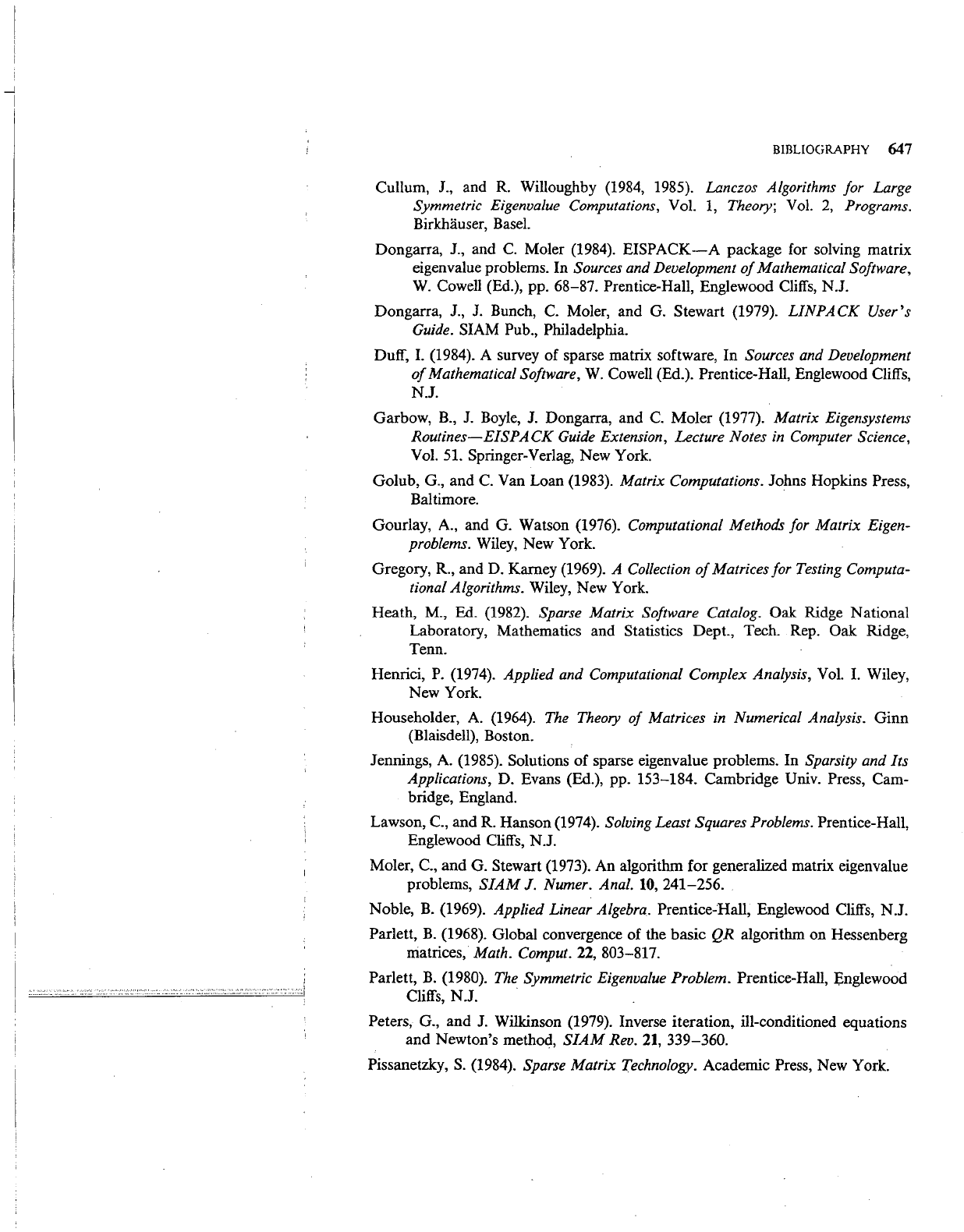
'
....
"'
--··:
·-~
·~'J
BIBLIOGRAPHY 647
Cullum, J., and
R.
Willoughby (1984, 1985). Lanczos Algorithms for Large
Symmetric Eigenvalue Computations,
VoL
1,
Theory;
VoL
2,
Programs.
Birkhauser,
BaseL
Dongarra, J., and
C.
Moler (1984).
EISPACK-A
package for solving matrix
eigenvalue problems.
In
Sources and Development
of
Mathematical Software,
W.
Cowell (Ed.), pp. 68-87. Prentice-Hall, Englewood Cliffs, N.J.
Dongarra, J., J. Bunch, C. Moler, and G. Stewart (1979).
LINPACK
User's
Guide. SIAM Pub., Philadelphia.
Duff, L (1984). A survey
of
sparse matrix software,
In
Sources and Development
of
Mathematical Software,
W.
Cowell (Ed.). Prentice-Hall, Englewood Cliffs,
N.J.
Garbow,
B.,
J. Boyle, J. Dongarra, and
C.
Moler
(1977). Matrix Eigensystems
Routines-EISPACK
Guide Extension, Lecture Notes in Computer Science,
Vol. 51. Springer-Verlag, New York.
Golub, G., and
C.
Van Loan (1983). Matrix Computations. Johns Hopkins Press,
Baltimore.
Gourlay, A., and
G. Watson (1976). Computational Methods for Matrix Eigen-
problems.
Wiley, New York.
Gregory, R., and
D. Karney (1969). A Collection
of
Matrices for Testing Computa-
tional Algorithms. Wiley, New York.
Heath, M., Ed. (1982).
Sparse Matrix Software Catalog. Oak Ridge National
Laboratory, Mathematics and
Statistics Dept., Tech. Rep.
Oak
Ridge,
Tenn.
Henrici,
P.
(1974). Applied and Computational Complex Analysis,
VoL
L Wiley,
New
York.
Householder,
A.
(1964). The Theory
of
Matrices in Numerical Analysis.
Ginn
(Blaisdell), Boston.
Jennings,
A.
(1985). Solutions
of
sparse eigenvalue problems.
In
Sparsity and Its
Applications,
D. Evans (Ed.), pp. 153-184. Cambridge Univ. Press, Cam-
bridge, England.
Lawson, C.,
and
R. Hanson (1974). Solving Least Squares Problems. Prentice-Hall,
Englewood Cliffs,
N.J.
Moler, C.,
and
G. Stewart (1973). An algorithm for generalized matrix eigenvalue
problems,
SIAM
J. Numer. Anal. 10, 241-256.
Noble,
B.
(1969). Applied Linear Algebra. Prentice-Hall, Englewood Cliffs, N.J.
Parlett,
B.
(1968). Global convergence
of
the
basic
QR algorithm
on
Hessenberg
matrices,
Math. Comput. 22, 803-817.
Parlett,
B.
(1980). The Symmetric Eigenvalue Problem. Prentice-Hall, Englewood
Cliffs, N.J.
.
Peters, G.,
and
J. Wilkinson (1979). Inverse iteration, ill-conditioned equations
and
Newton's method,
SIAM
Rev. 21,
339-360.
Pissanetzky,
S.
(1984). Sparse Matrix Technology. Academic Press, New York.
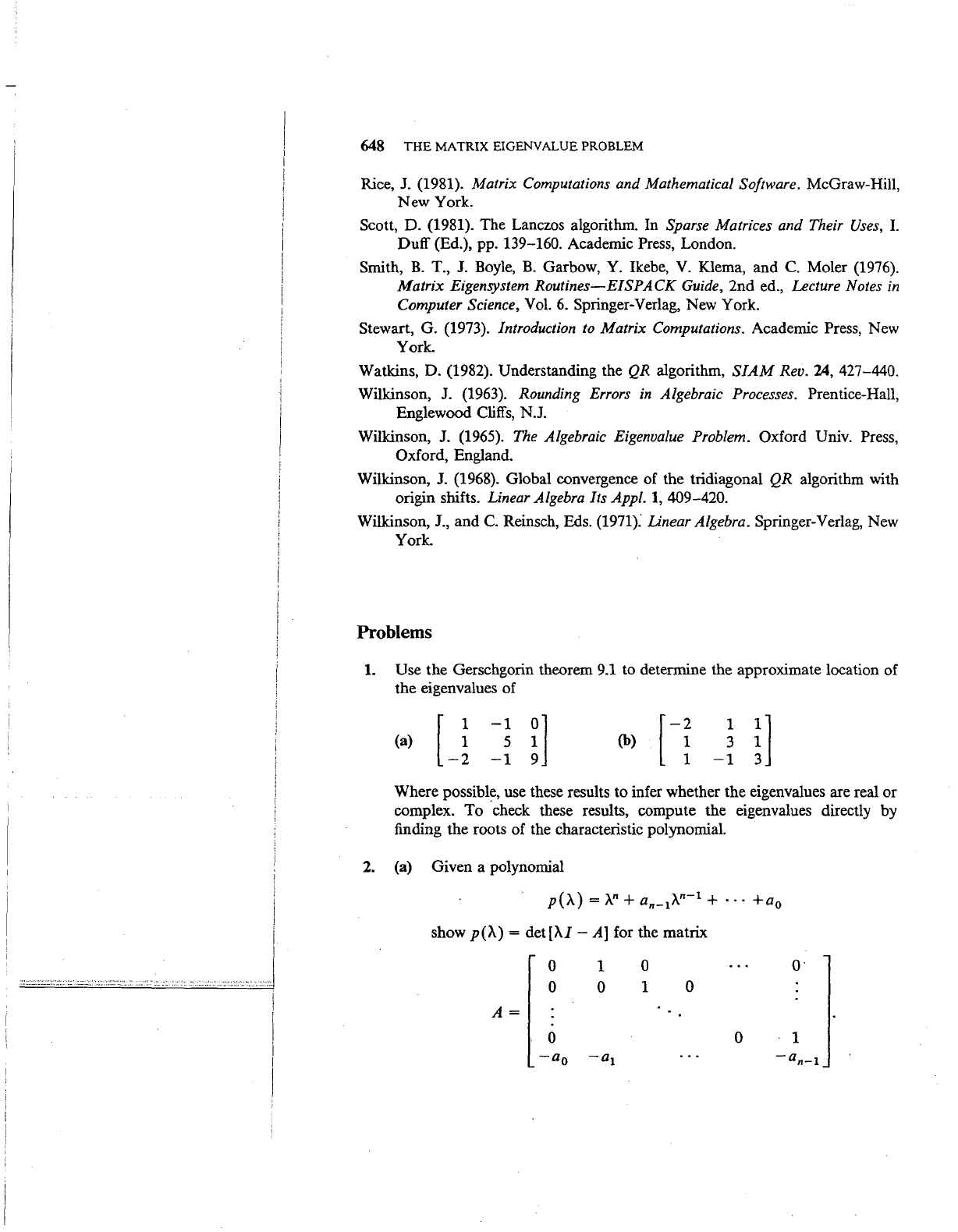
i
I
I
_.J
648
THE
MATRIX EIGENVALUE PROBLEM
Rice, J. (1981). Matrix Computations and Mathematical Software. McGraw-Hill,
New
York.
Scott,
D.
(1981). The Lanczos algorithm. In Sparse Matrices and Their
Uses,
I.
Duff
(Ed.), pp. 139-160. Academic Press, London.
Smith,
B.
T., J. Boyle,
B.
Garbow, Y. lkebe, V. Klema,
and
C. Moler (1976).
Matrix Eigensystem
Routines-EISPACK
Guide,
2nd
ed., Lecture Notes
in
Computer Science, Vol. 6. Springer-Verlag, New York.
Stewart,
G.
(1973). Introduction
to
Matrix Computations. Academic Press, New
York.
Watkins,
D.
(1982). Understanding the QR algorithm,
SIAM
Rev. 24, 427-440.
Wilkinson, J. (1963). Rounding Errors
in
Algebraic Processes. Prentice-Hall,
Englewood Cliffs, N.J.
Wilkinson, J. (1965). The Algebraic Eigenvalue Problem. Oxford Univ. Press,
Oxford, England.
Wilkinson, J. (1968). Global convergence of the tridiagonal
QR
algorithm with
origin shifts. Linear Algebra Its Appl.
1,
409-420.
Wilkinson, J.,
and
C.
Reinsch, Eds. (1971): Linear Algebra. Springer-Verlag, New
York.
Problems
1.
Use
the
Gerschgorin theorem
9.1
to determine the approximate location of
the
eigenvalues
of
(a)
[
1
_-
511
~9]
_;
Where possible, use these results to infer whether
the
eigenvalues are real
or
complex.
To
check these results, compute
the
eigenvalues directly by
finding
the
roots
of
the characteristic polynomial.
2. (a) Given a polynomial
p(A.)
=A"+
an-lA_n-1
+
...
+ao
show
p(A)
=
det[A.I-
AJ
for the matrix
A=
0
0
1
0
0
1 0
0 0
o·
1
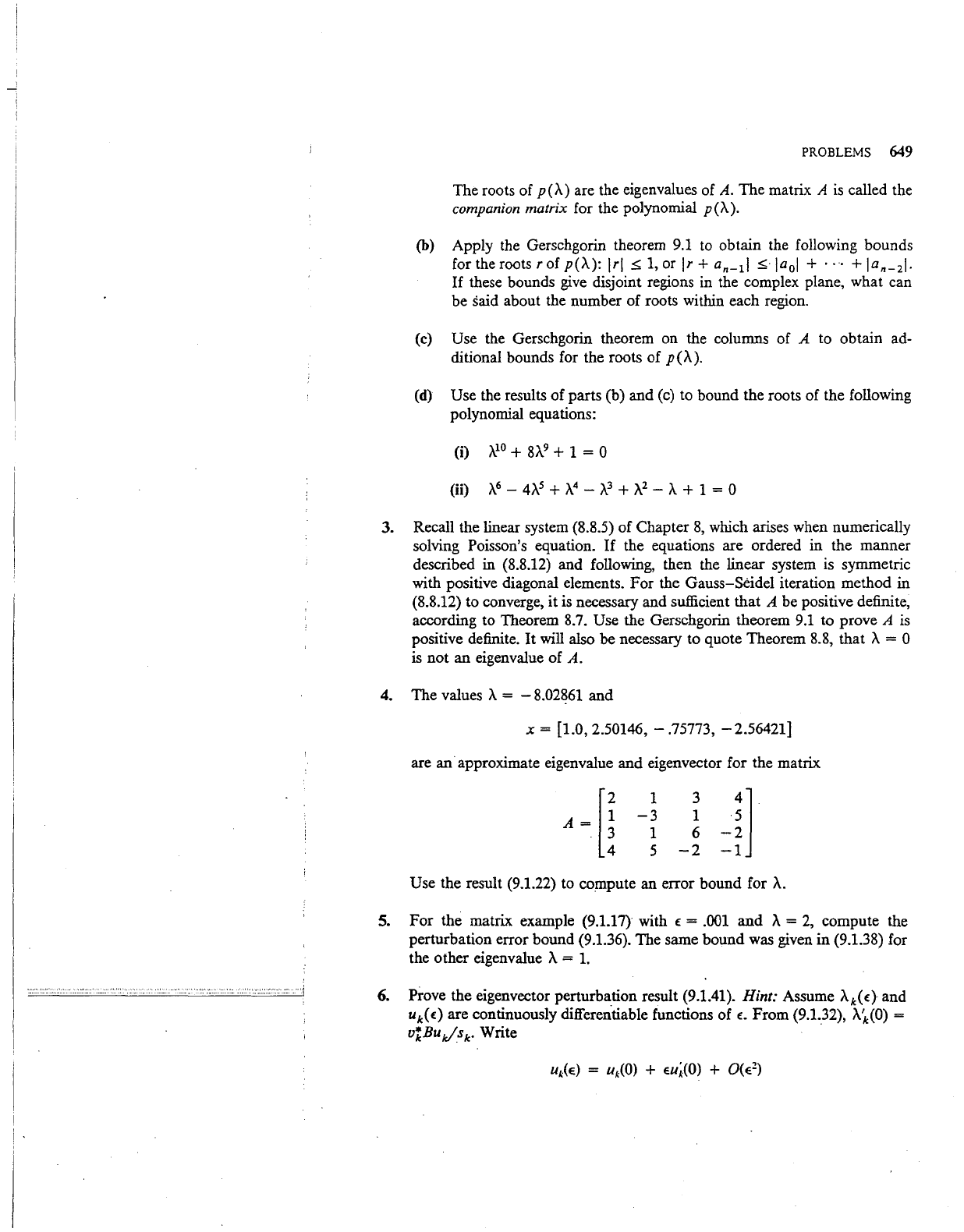
PROBLEMS 649
The roots of
p(A)
are the eigenvalues of A. The matrix A
is
called the
companion matrix for the polynomial p (A).
(b) Apply the Gerschgorin theorem
9.1
to obtain the following bounds
for the roots r of p(A):
!rl
=:;
1, or
!r
+ a,_d
:=;;;
ja
0
l + · · · +
Ja,_
2
J.
If
these bounds give disjoint regions in the complex plane, what can
be said about the number
of
roots within each region.
(c) Use the Gerschgorin theorem on the columns of A to obtain ad-
ditional bounds for the roots
of
p(A).
(d) Use the results
of
parts (b) and
(c)
to bound the roots
of
the following
polynomial equations:
3. Recall the linear system (8.8.5)
of
Chapter
8,
which arises when numerically
solving Poisson's equation.
If
the equations are ordered in the manner
described in (8.8.12) and following, then the linear system is symmetric
with positive diagonal elements.
For
the Gauss-Seidel iteration method in
(8.8.12) to converge, it is necessary and sufficient
that
A be positive definite,
according to Theorem 8.7. Use the Gerschgorin theorem
9.1
to prove A is
positive definite.
It
will also be necessary to quote Theorem 8.8, that A = 0
is not
an
eigenvalue of A.
4. The values A = - 8.02861
and
X=
[1.0, 2.50146,
-.75773,
-2.56421)
are an· approximate eigenvalue
and
eigenvector for the matrix
A=
[i
. 3
4
1
-3
1
5
3
1
6
-2
4].
5
-2
-1
Use the result (9.1.22) to compute
an
error bound for
A.
5.
For
the matrix example (9.1.17) with f =
.001
and
A =
2,
compute the
perturbation error bound (9.1.36). The same bound was given
in
(9.1.38) for
the other eigenvalue A =
1.
6. Prove the eigenvector perturbation result (9.1.41). Hint: Assume Ak(f} and
uk(f)
are continuously differentiable functions
of
f.
From
(9.1.32),
A'k(O)
=
vZBukf'sk. Write
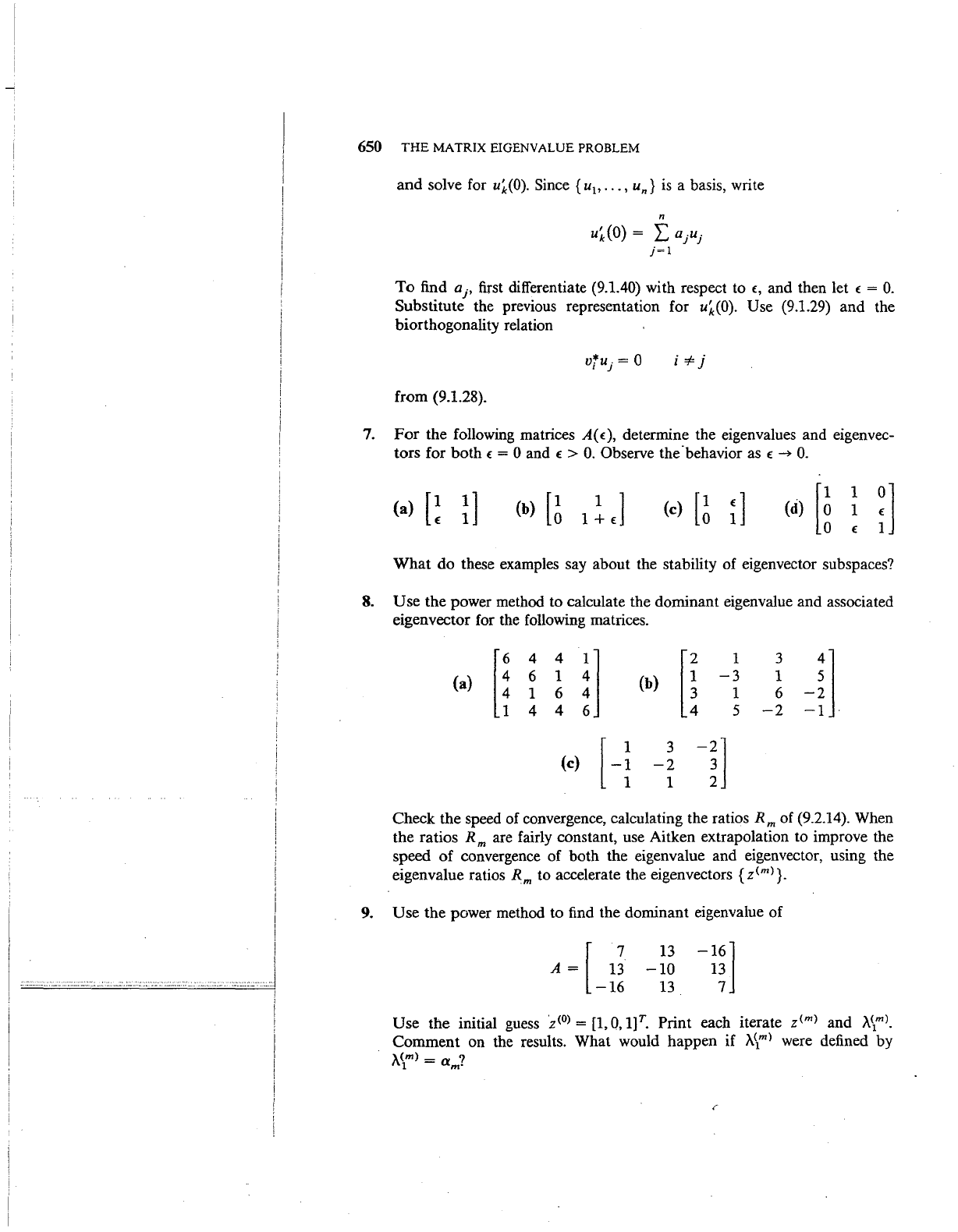
650
THE
MATRIX EIGENVALUE PROBLEM
and
solve for
u~(O).
Since { u
1
,
...
, un}
is
a basis, write
n
uk(O)
=
~
ajuj
j=l
To
find aj, first differentiate (9.1.40) with respect to
E:,
and then let
E:
=
0.
Substitute the previous representation for
uk(O).
Use (9.1.29) and the
biorthogonality relation
from
(9.1.28).
7.
For
the following matrices
A(
i),
determine the eigenvalues and eigenvec-
tors for both
E:
= 0 and i >
0.
Observe the.behavior as
E:
~
0.
(a)
[!
(b)
[ol
1 ]
1 + i
(c)
[~
n
(d)
[~
1
1
What
do
these examples say about the stability of eigenvector subspaces?
8.
Use the power method to calculate the dominant eigenvalue and associated
eigenvector for the following matrices.
9.
(a)
4 4
6 1
1 6
4 4
(b)
1
-3
1
5
3
1
6
-2
41
5
-2
-1
.
Check the speed of convergence, calculating the ratios
Rm
of (9.2.14). When
the ratios
Rm
are fairly constant, use Aitken extrapolation to improve the
speed
of
convergence of both the eigenvalue and eigenvector, using the
eigenvalue ratios
Rm
to accelerate the eigenvectors {
z<m>
}.
Use the power method to find the dominant eigenvalue of
A=
[
1~
-16
13
-10
13
-16]
13
7
Use the initial guess
z<
0
> =
[1,
0,
If.
Print each iterate
z<m>
and
>..)m>.
Comment on the results. What would happen if
>..)ml
were defined by
>._)m)
=am?
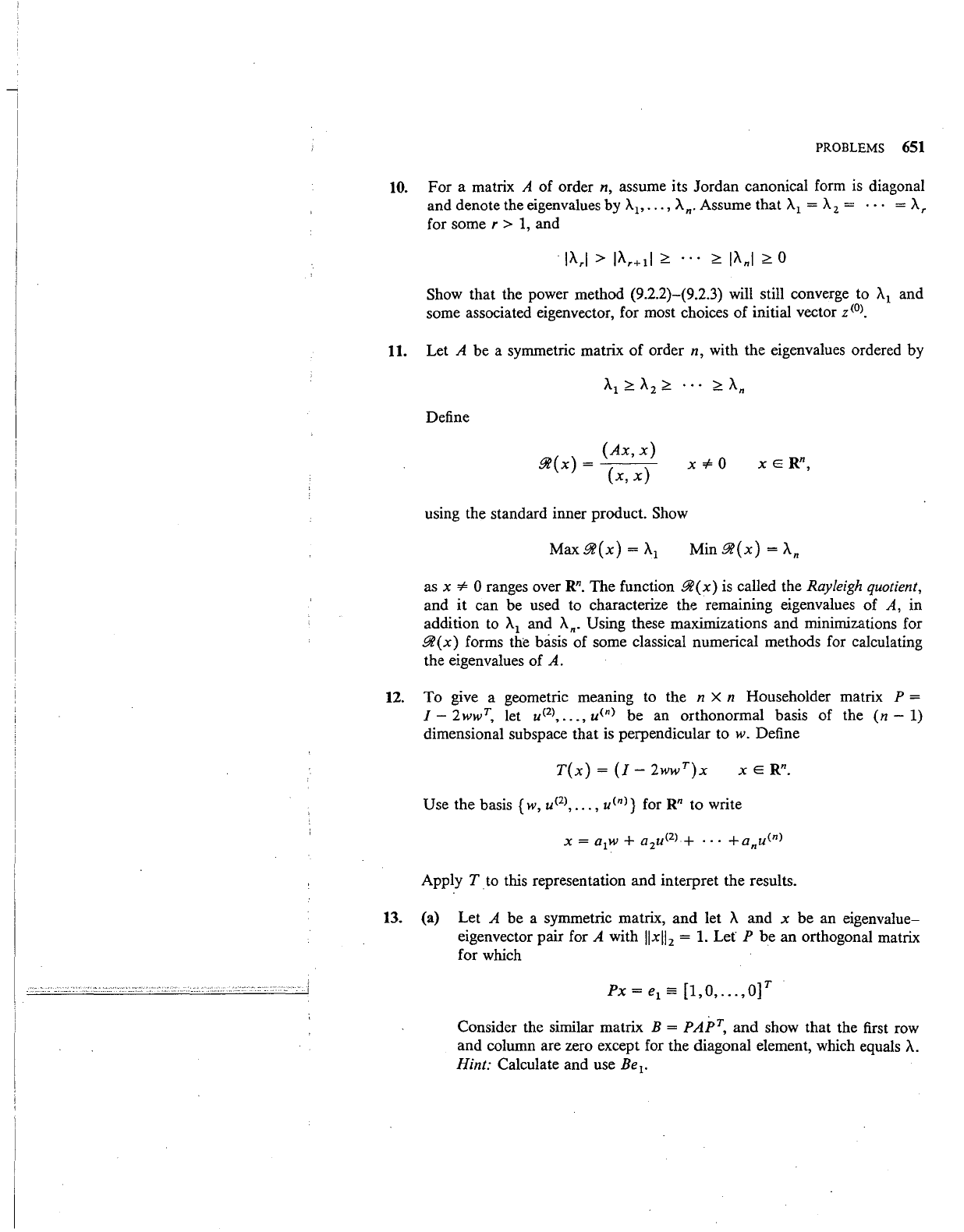
. '
..
. .
·'·
....
~.·
.•.
····"
":
".'
:.:·····
.•.
"i
PROBLEMS
651
10.
For a matrix A of order n, assume its Jordan canonical form
is
diagonal
and denote the eigenvalues by
A
1
,
...
,
An.
Assume that A
1
= A
2
= · · ·
=A,
for some r >
1,
and
Show that the power method
(9.2.2)-(9.2.3) will still converge to A
1
and
some associated eigenvector, for most choices of initial vector
z<
0
>.
11.
Let A be a symmetric matrix of order n, with the eigenvalues ordered by
Define
(Ax,
x)
9i(x)=
( )
x,x
using the standard inner product. Show
Min
9i(x)
=An
as x
=F
0 ranges over
Rn.
The function
9i(x)
is
called the Rayleigh quotient,
and
it
can be used to characterize the remaining eigenvalues of A, in
addition to
A
1
and
An.
Using these maximizations and minimizations for
9i(x)
forms the basis of some classical numerical methods for calculating
the eigenvalues of
A.
12. To give a geometric meaning to the n X n Householder matrix P =
I-
2wwT, let
u<
2
>,
... ,
u<n)
be an orthonormal basis of the
(n-
1)
dimensional subspace that
is
perpendicular to
w.
Define
T(x)
=
(I-
2wwT)x
Use the basis { w,
u(2),
...
,
u<nl}
for
Rn
to write
Apply T
to
this representation and interpret the results.
13.
(a) Let A be a symmetric matrix,
and
let A and x be an eigenvalue-
eigenvector pair for
A with
llxllz
=
1.
Let
P be an orthogonal matrix
for which
Px = e
1
=
[l,O,
...
,OV
Consider the similar matrix B = PAPT, and show that the first row
and column are zero except for the diagonal element, which equals
A.
Hint: Calculate and use Be
1
•
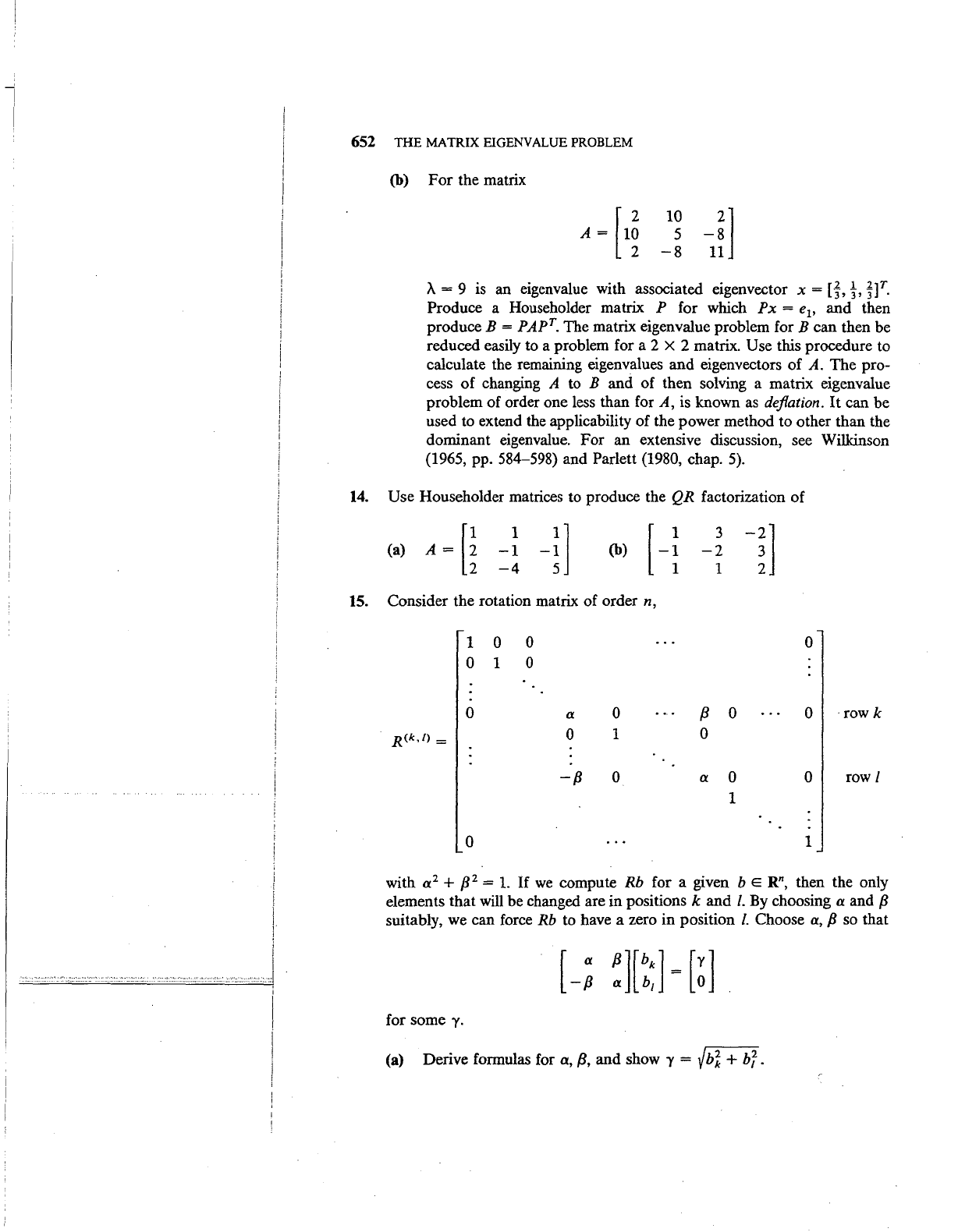
l
652
THE
MATRIX EIGENVALUE PROBLEM
(b)
For
the matrix
10
5
-8
-i]
11
A = 9 is an eigenvalue with associated eigenvector x = [
~,
t,
~f.
Produce a Householder matrix P for which
Px
= e
1
,
and
then
produce
B = PAPr. The matrix eigenvalue problem
forB
can
then be
reduced easily to a problem for a 2
X 2 matrix. Use this procedure to
calculate the remaining eigenvalues
and
eigenvectors
of
A.
The
pro-
cess
of
changing A to B
and
of
then solving a matrix eigenvalue
problem
of
order one less than for
A,
is known as deflation.
It
can
be
used to extend the applicability
of
the power method to other
than
the
dominant
eigenvalue.
For
an
extensive discussion, see Wilkinson
(1965, pp. 584-598) and Parlett
(1980, chap. 5).
14.
Use
Householder matrices to produce the
QR
factorization
of
15.
A~
u
1
~~]
H
3
~~]
(a)
-1
(b)
-2
-4
1
Consider
the
rotation matrix
of
order n,
1 0
0 0
0 1 0
0
a 0
/3
0
0
·row
k
R<k.t>
=
0
1
0
-/3
0
a
0
0
row I
1
0
1
with a
2
+
/3
2
=
1.
If
we
compute Rb for a given b E
Rn,
then the only
elements
that
will
be
changed are
in
positions k
and
I.
By choosing a and
/3
suitably, we can force Rb to have a zero
in
position
I.
Choose a,
/3
so that
for some
y.
(a) Derive formulas for a,
/3,
and
show y =
Vbz
+hi.
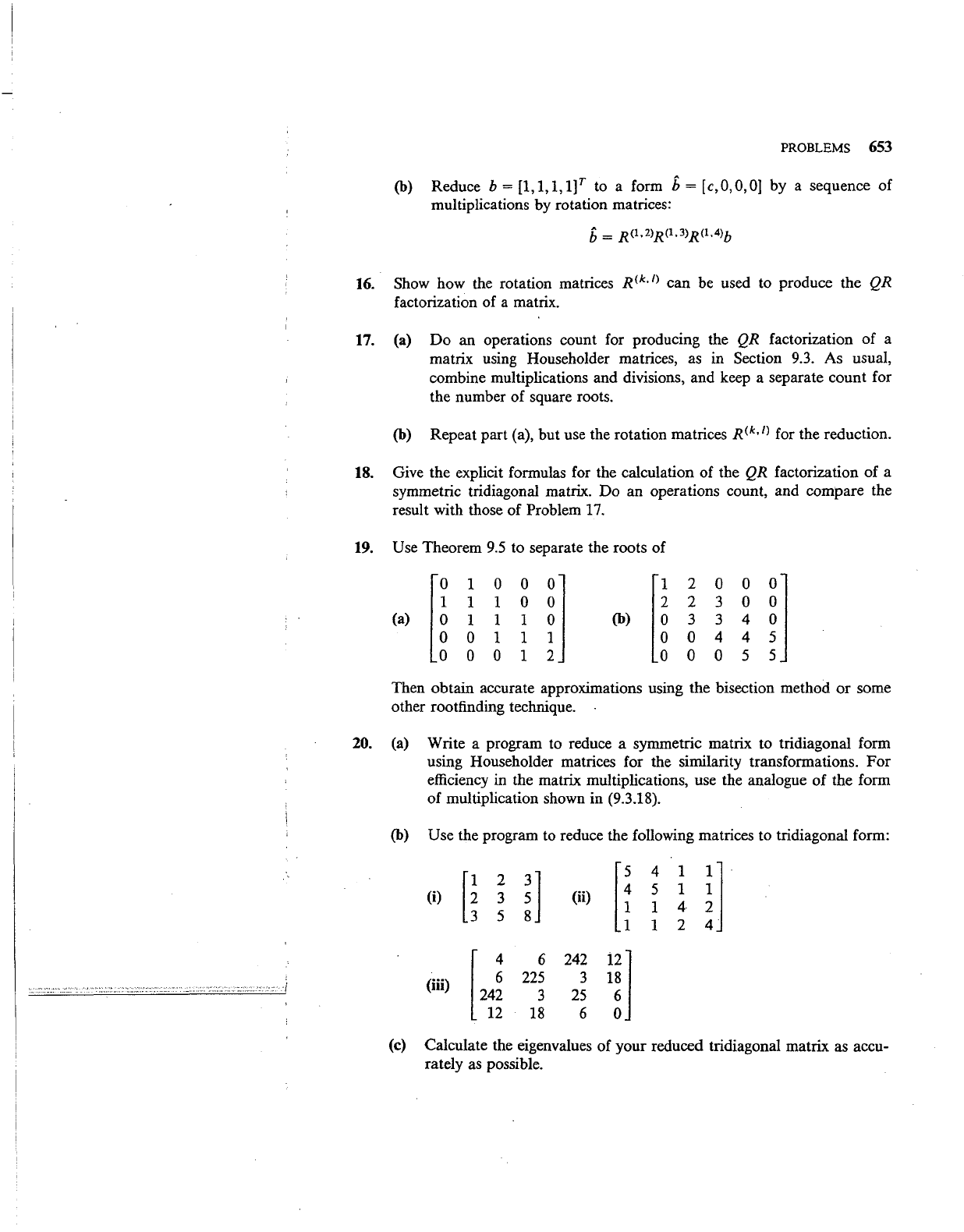
I
'
....
,
................
··---·--
·-
-·--·
·-·--
.........
PROBLEMS 653
(b) Reduce
b=[1,1,1,1f
to a form
h=[c,O,O,O]
by a sequence
of
multiplications by rotation matrices:
16. Show how the rotation matrices
R<k.l)
can
be used to produce the
QR
factorization of a matrix.
17. (a)
Do
an
operations count for producing the
QR
factorization
of
a
matrix using Householder matrices, as in Section 9.3. As usual,
combine multiplications and divisions, and keep a separate count for
the number
of
square roots.
(b) Repeat part (a), but use the rotation matrices
R(k,/)
for the reduction.
18. Give the explicit formulas for the calculation
of
the
QR
factorization
of
a
symmetric tridiagonal matrix.
Do
an
operations count, and compare the
result with those
of
Problem 17.
19.
Use Theorem
9.5
to separate the roots
of
r~
1 0 0
!l
l~
2
0 0
~l
1 1 0
2 3 0
(a)
1
1 1
(b)
3
3
4
0 1 1
0 4 4
0 0
1
0 0 5
Then
obtain
accurate approximations using the bisection method
or
some
other rootfinding technique.
20. (a) Write a program to reduce a symmetric matrix to tridiagonal form
using Householder matrices for the similarity transformations.
For
efficiency in the matrix multiplications, use the analogue
of
the form
of
multiplication shown
in
(9.3.18).
(b) Use the program to reduce the following matrices to tridiagonal form:
[~
2
!]
[[
4
1
il
(i)
3
(ii)
5
1
1
4
5
1
2
4
[
24i
6
242
12]
(iii)
225 3
18
3
25
6
12
18
6
0
(c) Calculate the eigenvalues
of
your reduced tridiagonal matrix as accu-
rately as possible.
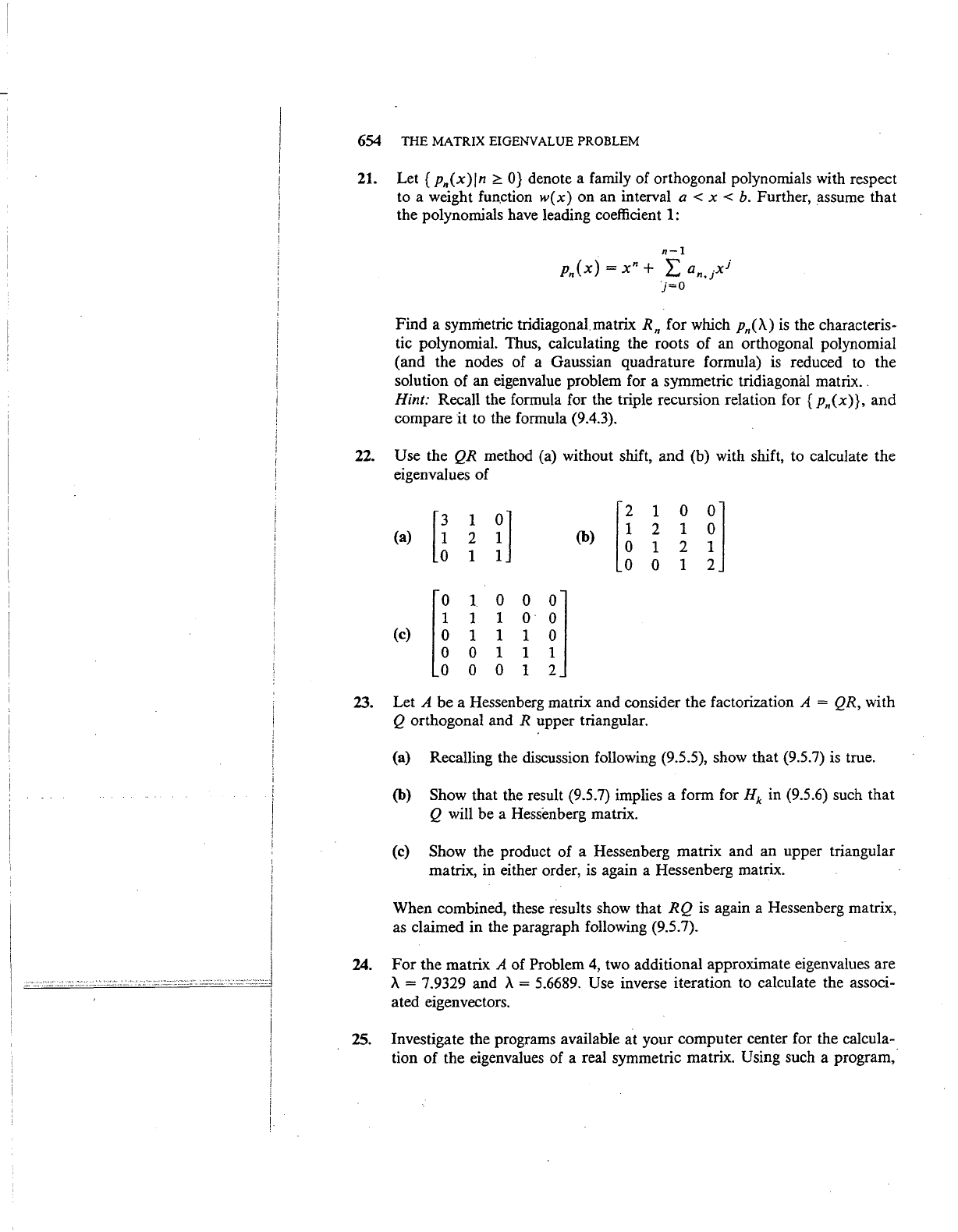
I
i
!
I
I
--
-. -
--
----
-
..
-
.J
i
!
654
THE MATRIX EIGENVALUE PROBLEM
21. Let { Pn(x)jn
~
0}
denote a family of orthogonal polynomials with respect
to a weight fun.ction
w(x)
on an interval a < x <
b.
Further, assume that
the polynomials have leading coefficient 1:
n-1
P
(x)
=xn+
"a
-Xj
n £...,
n,;
j=O
Find a symmetric tridiagonal. matrix
Rn
for which
PnCJ...)
is the characteris-
tic polynomial. Thus, calculating the roots
of
an orthogonal polynomial
(and the nodes of a Gaussian quadrature formula) is reduced to the
solution of an eigenvalue problem for a symmetric tridiagonal matrix
..
Hint: Recall the formula for the triple recursion relation for { Pn(x)},
and
compare
it
to the formula (9.4.3).
22.
Use the
QR
method (a) without shift,
and
(b) with shift, to calculate the
eigenvalues of
[!
1
:J
r~
1
0
fl
(a)
2
(b)
2
1
1
2
1
0
1
[f
1
0
0
~J
1
1 0
(c)
1
1
1
0
1 1
0 0
1
23. Let A be a Hessenberg matrix and consider the factorization A = QR, with
Q orthogonal and R upper triangular.
24.
25.
(a) Recalling the discussion following (9.5.5), show that (9.5.7) is true.
(b) Show that the result (9.5.7) implies a form for
Hk
in (9.5.6) such
that
Q will be a Hessenberg matrix.
(c) Show the product
of
a Hessenberg matrix and an upper triangular
matrix, in either order, is again a Hessenberg matrix.
When combined, these results show that
RQ
is
again a Hessenberg matrix,
as claimed in the paragraph following (9.5.7).
For
the matrix A of Problem 4, two additional approximate eigenvalues are
A = 7.9329 and A = 5.6689. Use inverse iteration to calculate the associ-
ated eigenvectors.
Investigate the programs available
at
your computer center for the calcula-
tion
of
the eigenvalues of a real symmetric matrix. Using such a program,
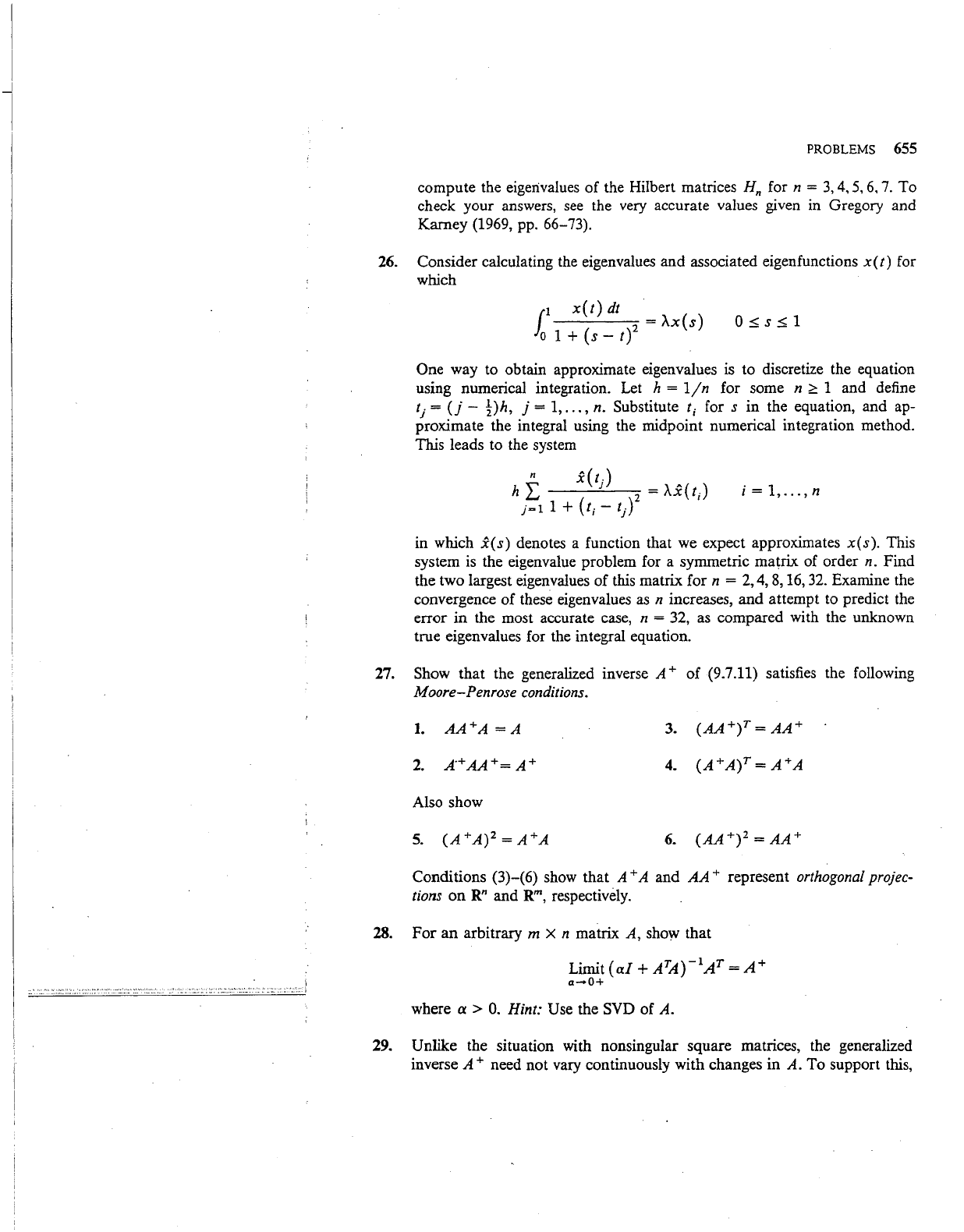
PROBLEMS
655
compute the eigenvalues
of
the Hilbert matrices
Hn
for n =
3,
4,
5,
6,
7.
To
check your answers,
see
the very accurate values given in Gregory and
Karney (1969, pp. 66-73).
26.
Consider calculating the eigenvalues and associated eigenfunctions
x(
t)
for
which
1
1
x(t)
dt
_
_,;_
__
2
=
A.x(s)
o 1 +
(s-
t)
O~s~1
One way to obtain approximate eigenvalues is to discretize the equation
using numerical integration. Let h =
1/n
for some n
2::
1 and define
tj
= (} - t)h, j = 1,
...
, n. Substitute
t;
for s
in
the equation,
and
ap-
proximate the integral using the midpoint numerical integration method.
This leads to the system
n
A(t
)
h L X j 2 =
AX
( t
i)
j~I1+(t;-tJ
i = 1,
...
, n
in which
x(s)
denotes a function that we expect approximates
x(s).
This
system
is
the eigenvalue problem for a symmetric matrix of order n.
Find
the two largest eigenvalues
of
this matrix for n = 2, 4,
8,
16, 32. Examine the
convergence
of
these eigenvalues as n increases,
and
attempt to predict the
error
in
the most accurate case, n = 32, as compared with the unknown
true eigenvalues for the integral equation.
27. Show that the generalized inverse
A+
of
(9.7.11) satisfies the following
Moore-Penrose conditions.
1.
AA+A
=A
Also show
Conditions
(3)-(6)
show
that
A+
A and
AA
+ represent orthogonal projec-
tions
on
Rn
and
Rm,
respectively.
28.
For
an
arbitrary m X n matrix
A,
show that
Limit
(a/+
ATA)-
1
AT
=A+
a-0+
where a > 0. Hint: Use the SVD of
A.
29. Unlike the situation with nonsingular square matrices, the generalized
inverse
A+
need not vary continuously with changes
in
A.
To
support this,
